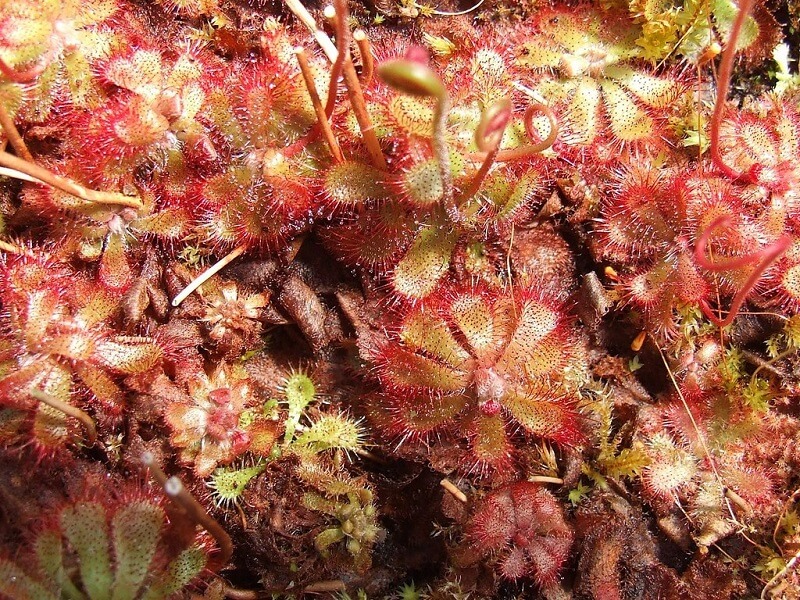Although not quite so hardy or easy to propagate as the Cape Sundew, the Alice Sundew is one of the most widely sold rosette sundews and easy to grow if given suitable conditions. It is a slow growing species, but tolerant of occasional abuses, and besides its highly attractive foliage it also rewards the gardener with lovely pink flowers throughout the year.
Rosette sundews are low-lying plants consisting of tight whorls of short leaves. Mature plants send out short runners that develop into daughter plants, so that eventually a single plant becomes a whole clump of plants. The Alice Sundew is a typical example, with a rosette about three inches in diameter made up of tapering, almost tear-shaped leaves.
Like all other sundews, its leaves are covered with sticky tentacles. Healthy plants glisten with nectar, and they use this to lure insects onto their leaves. Should an insect land on a leaf it quickly finds itself stuck firmly in place, and the more it struggles, the more it becomes entangled. Small prey are held in place by the tentacles alone, but the Alice Sundew curls its leaves backwards to secure larger prey before digestion begins.
Alice Sundews must be watered with pure, mineral-free water. The cheapest and easiest source of pure water for most indoor gardeners will be rainwater, but deionised or distilled water can be used instead. Tap water, mineral water, or water from a domestic water softener cannot be used.
As with most other carnivorous plants, the best way to water Alice Sundews is to keep them standing in a planter partially filled with water. This will keep the soil water logged and also produces a bit of humidity around the plant that keeps the leaves from turning brown during the summer.
Alice Sundews must be grown in a lime-free substrate. They do very well in a 50/50 mixture of peat and silica sand.
Like most sundews, the Alice Sundew appreciates good, strong light. Under such conditions the leaves will turn red, making the plants even more attractive. In temperate parts of the world, Alice Sundews will do very well outdoors though they can be grown successfully all year round either on a sunny windowsill or in a cool greenhouse.

Source
Like Cape Sundews, Alice Sundews do best given a bit of season variation. High summertime temperatures are tolerated very well, provided the pots are in standing water. If the leaves turn brown at the edges, that’s a good sign the plants aren’t getting enough water or humidity.
Alice Sundews will tolerate occasional light frosts, and while this kills off the foliage above the ground, the plants will recover and produce new leaves in spring. However, they are subtropical plants in the wild, and in most temperate zone locations will need to be brought indoors by the middle of autumn once the nights become chilly. The plants can be overwintered in a cool greenhouse or indoors on a sunny windowsill, ideally in an unheated room, though this isn’t as essential as it is for temperate zone carnivorous plants like Venus’ Flytraps.
Alice Sundews aren’t quite as easy to grow from seed as the Cape Sundews, but this is still a good way to produce lots of baby plants. Simply scatter the seeds on a wet mixture of peat and silica sand, and then keep them sunny, warm (around 75 degrees Fahrenheit) and damp. Do bear in mind that the seeds may take two months to germinate, and sundew seedlings are relatively slow growing.
Alice Sundews produce long stalks bearing pink flowers throughout the year. Like Cape Sundews, Alice Sundews are self fertile. This means that their flowers can pollinate themselves, and thereby produce viable seeds. Once the flowers have lost their petals and started to dry up, it’s worth shaking them gently over a piece of paper to see if any seed has formed.
Because they naturally form clumps, the easiest way to propagate this species is simply to divide mature plants into two or more plants and repot them as required. When doing this, take care to cleave away the daughter plants without damaging the mother plant’s roots.